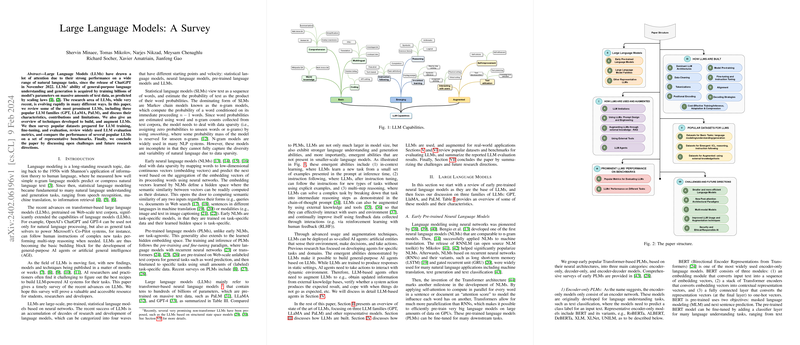Surveying the Evolution and Future of LLMs: Insights and Directions
Introduction to LLMs
The landscape of NLP and AI has been profoundly reshaped with the advent of LLMs. A pivotal point in this evolution was marked by the introduction of models such as GPT, LLaMA, and PaLM, which significantly advanced the capabilities of language understanding and generation. These models excel in absorbing and generating human language by leveraging billions of parameters and extensive text data. This survey explores the development, applications, and challenges associated with LLMs, offering a panorama on their impact and potential.
Early Foundations and Key LLM Families
The journey towards sophisticated LLMs began with foundational models like BERT, which introduced the transformer architecture, optimizing parallel computation and attention mechanisms. This laid the groundwork for subsequent models grouped into families based on their architecture and capabilities.
- GPT Family: Characterized by their decoder-only transformer architecture, the GPT series demonstrated the potential of pre-trained models across various NLP tasks. Each iteration, from GPT-1 through GPT-4, brought enhancements in model size and task efficiency, showcasing emergent abilities like in-context learning and advanced task-solving capabilities.
- LLaMA Family: Meta's LLaMA models, spanning from 7B to 65B parameters, are notable for their open-source availability, making them accessible for research and development. These models have shown competitive performance even against proprietary counterparts, indicating a promising direction for the democratization of AI technology.
- PaLM Family: Google's PaLM models push the envelope in LLMs with up to 540B parameters. Demonstrating state-of-the-art performance across diverse benchmarks, PaLM models highlight the continued benefits of scaling, including enhanced reasoning and multilingual capabilities.
Building and Augmenting LLMs
LLMs are constructed on the bedrock of neural networks, benefiting from decades of LLM research. This segment covers the evolution from statistical models to neural-based approaches, highlighting the shift towards pre-trained models capable of general and specific tasks. Techniques like Tokenization and Positional Encoding are pivotal in optimizing LLMs for efficiency and context understanding.
Augmentation strategies like using external knowledge and tools have expanded LLMs' application realms. Retrieval Augmented Generation (RAG) and direct tool usage enable models to interact with dynamic data and perform actions, pushing LLMs towards the field of AI Agents. Advanced prompting techniques, including Chain of Thought and Self-Consistency, further refine LLMs' output, enhancing their reasoning and reliability.
Datasets and Evaluation Benchmarks
The effectiveness of LLMs is benchmarked across a variety of datasets, from basic language understanding tasks to emergent capabilities like instruction following and reasoning. This evaluation landscape includes benchmarks such as Natural Questions, MMLU, and WebQ, offering insights into models' performance across domains. The discussion also encompasses the challenges of evaluating LLMs, particularly in tasks requiring nuanced understanding or creative generation.
Performance Comparison and Insights
Prominent LLMs are evaluated against established benchmarks, revealing strengths and areas for improvement. Models like GPT-4 and PaLM have set high standards, especially in tasks demanding deep knowledge and reasoning. Yet, no single model dominates across all benchmarks, indicating a competitive and diverse ecosystem.
Challenges and Future Research Directions
The survey concludes with an exploration of ongoing challenges and potential research directions. These include efforts towards more efficient and smaller models, the exploration of post-attention architectural paradigms, and the integration of multi-modal capabilities. Security, ethical considerations, and bias mitigation remain crucial areas for responsible AI development.
Conclusion
LLMs represent a significant milestone in AI, transforming natural language understanding and generation. The rapid evolution of LLMs, coupled with a thriving research ecosystem, promises continued advancements and broader applications. As LLMs grow in sophistication, they bring us closer to developing AI systems with a deeper understanding of human language and logic, heralding a new era of innovation and cooperation between humans and machines.
